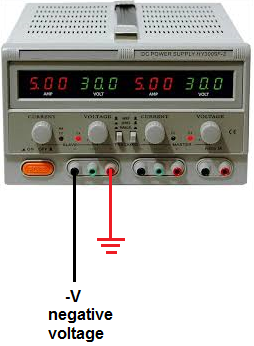How to Obtain Negative Voltage from a DC Power Supply or Battery

Negative voltage is an important of electronics.
It's used many times for various types of circuits.
One example where negative voltage is used for dual supply operational amplifiers. Many times, these amplifiers deal with AC signals. Therefore, positive and negative rails need to be established; and they are established through the application of positive and negative DC voltages to the op amp. Therefore, many chips including the popular LM741 operational amplifier, makes use of negative voltage.
Another place where negative voltage is used is for various transistors. For example, with an N-channel JFET, negative voltage to the base of the transistor causes current to cease at the output. So negative voltage causes the transistor to turn off. For a P-channel enhancement-type MOSFET, negative voltage causes the transistor to turn on. For a P-channel depletion-type MOSFET, negative voltage causes the transistor to turn off.
Negative voltage is also needed as input for negative voltage regulators.
So, negative voltage is widely used in electronics. So it's very important to know how to connect negative voltage, because you will need it for many circuits.
The 2 main sources of DC power are from DC power supplies and batteries. Therefore, we will show how to connect these
devices so that they produce negative negative.
DC Power Supply
Let's begin with the DC power supply.
So a DC power supply normally has 3 terminals: +, GND, and -.
The + is the positive terminal of the voltage supply.
The - is the negative terminal of the DC voltage supply.
And ground is earth ground.
The earth ground can connect to either nothing (left floating), the + terminal or the - terminal. We will show how to connect it left floating and connect to ground with negative voltage supplied.
Earth ground is used to provide protection for the circuit but it isn't always needed. Depending on your circuit needs, it can be left floating. However, it can be connected. We'll show both cases.
To connect negative voltage simply without considering ground at all (which is probably how you'll wire up the circuit most of the time if you're just wiring basic circuits), all you have to do is connect the positive terminal to the ground of the circuit and the negative terminal to part of the circuit you want to connect negative voltage to. This provides negative voltage to the power supply.
The diagram below shows negative voltage from a DC power supply.

You can see in the diagram that the positive terminal connects to ground and the negative terminal then connects to whatever part needs negative voltage.
If you want to connect negative voltage with earth ground, then all you have to do is tie the earth ground terminal of the DC power supply and the positive terminal common. This makes the positive terminal grounded to earth. And the negative terminal then connects to whichever part needed to supply negative voltage.
It's relatively simple.
Battery
A battery is even simpler.
A battery doesn't have earth ground.
A battery simply has 2 terminals: + and -.
To connect negative voltage from a battery, we simply tie the positive terminal of the battery to ground and the negative terminal of the battery to whatever part needs negative voltage.
The diagram below illustrates this concept.

So you can see based on the diagram that the positive terminal of the battery will
connect to the ground of the circuit and the negative terminal of the battery will connect to whatever
circuit needs negative voltage.
So this is all that is necessary to supply negative voltage either from a DC power supply or a battery.
An easy check to do if you have a multimeter is to take the multimeter and measure the DC voltage. Place the positive
probe of the multimeter on the negative voltage and the negative probe of the multimeter on ground. If the multimeter reads voltage with a minus
sign in front of it, it is negative voltage. This means you truly are inputting negative voltage. So this is the check you can do.
To see how this translates in real life, see the following video below.
Related Resources
How to Use the LM741 Op Amp as a Comparator
How to Build an LM339 Quad Voltage Comparator Circuit
How to Build a Dark-activated Switch
How to Build a Hall Effect Sensor Circuit
How to Build a Touch Sensor Circuit
How to Build an Accelerometer Circuit
How to Build a Motion Detector Circuit
How to Build a Motion Detector Alarm Circuit
